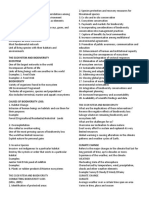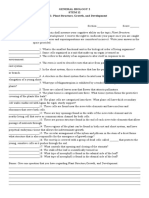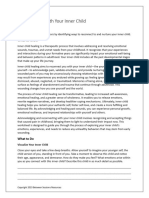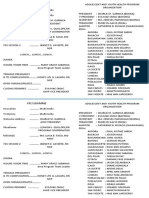0 ratings0% found this document useful (0 votes)
171 viewsq1 Perdev Module 3 Lesson 2 Why Am I Like This
q1 Perdev Module 3 Lesson 2 Why Am I Like This
Uploaded by
BaiArwa Talipasan- While peers become increasingly important sources of support and influence during adolescence, the family continues to provide stability, security, and unconditional love and support, especially during challenging times. Ongoing positive family connections are protective factors for adolescents' well-being.
- Adolescents still rely on their family as an emotional base from which to explore independence and identity formation. They benefit from expectations, caring relationships, and having a place to fall back on for reassurance.
- While the parent-child relationship changes to become more collaborative
Copyright:
© All Rights Reserved
Available Formats
Download as PPTX, PDF, TXT or read online from Scribd
q1 Perdev Module 3 Lesson 2 Why Am I Like This
q1 Perdev Module 3 Lesson 2 Why Am I Like This
Uploaded by
BaiArwa Talipasan0 ratings0% found this document useful (0 votes)
171 views27 pages- While peers become increasingly important sources of support and influence during adolescence, the family continues to provide stability, security, and unconditional love and support, especially during challenging times. Ongoing positive family connections are protective factors for adolescents' well-being.
- Adolescents still rely on their family as an emotional base from which to explore independence and identity formation. They benefit from expectations, caring relationships, and having a place to fall back on for reassurance.
- While the parent-child relationship changes to become more collaborative
Original Title
q1 Perdev Module 3 Lesson 2 Why Am i Like This
Copyright
© © All Rights Reserved
Available Formats
PPTX, PDF, TXT or read online from Scribd
Share this document
Did you find this document useful?
Is this content inappropriate?
- While peers become increasingly important sources of support and influence during adolescence, the family continues to provide stability, security, and unconditional love and support, especially during challenging times. Ongoing positive family connections are protective factors for adolescents' well-being.
- Adolescents still rely on their family as an emotional base from which to explore independence and identity formation. They benefit from expectations, caring relationships, and having a place to fall back on for reassurance.
- While the parent-child relationship changes to become more collaborative
Copyright:
© All Rights Reserved
Available Formats
Download as PPTX, PDF, TXT or read online from Scribd
Download as pptx, pdf, or txt
0 ratings0% found this document useful (0 votes)
171 views27 pagesq1 Perdev Module 3 Lesson 2 Why Am I Like This
q1 Perdev Module 3 Lesson 2 Why Am I Like This
Uploaded by
BaiArwa Talipasan- While peers become increasingly important sources of support and influence during adolescence, the family continues to provide stability, security, and unconditional love and support, especially during challenging times. Ongoing positive family connections are protective factors for adolescents' well-being.
- Adolescents still rely on their family as an emotional base from which to explore independence and identity formation. They benefit from expectations, caring relationships, and having a place to fall back on for reassurance.
- While the parent-child relationship changes to become more collaborative
Copyright:
© All Rights Reserved
Available Formats
Download as PPTX, PDF, TXT or read online from Scribd
Download as pptx, pdf, or txt
You are on page 1of 27
At the end of the lesson, the students
should be able to:
• develop understanding about physical, physiological, and
psychological issues related to the processes of growing up;
• explain the nature of adolescence as a developmental stage;
and
• explain the physical development during adolescence.
Evaluation of an
Adolescent’s
Development through
the Significant People
in their Lives
Society plays a huge role in molding
teens’ behavior, character, and attitude.
It determines how they see other people,
their general outlook, and their ethics.
Parents, and other family members, can also
influence all these things, but the things that
will remain with the kids for the long term are
learned from society. Now society comprises of
a lot of different things that include media,
neighborhood, laws, and school.
PEERS
Social and emotional maturity is intertwined.
- As teens’ emotional maturity increases, their
relationships with their peers change as they
become more vulnerable and emotionally
intimate. This increased vulnerability and
intimacy require greater trust among peers.
Teens modify their behavior,
activities, etc. to be accepted by a
peer group
Since acceptance by a peer group becomes essential, teens
modify their speech, dress, behavior, choices, and activities to
become more similar to their peers. This increased similarity
among peers provides them a sense of security and affirms
their acceptance into their chosen peer group.
The developmental theorist Erik Erickson described this
developmental step as a crisis of identity vs. identity
confusion.
• When teens modify their choices or behavior
in order to conform to what their friends are
doing, they are adapting to peer pressure.
• Peer pressure is often associated with adverse
outcomes such as skipping school, wearing
distasteful clothing, or drinking alcohol, and
using drugs.
• However, many parents do not recognize that
peer pressure may also have a positive
influence. Because of advanced cognitive and
emotional maturity, teens can now encourage
each other to make wise decisions and
discourage them from making wrong choices.
• Since it is vital for youth to "fit in" with their peer group,
they may also decide to participate in the same hobbies or
activities as their friends. Doing so will enable them to
spend more time together and to bond over shared
experiences. In general, teens will gravitate toward peer
groups with whom they share common interests and
activities, similar cultural backgrounds, or simply a
similar outlook on life. Nevertheless, as teens experiment
with their identity, they may be attracted to peer groups
with very different interests.
• In summary, during adolescence, the number of
close friendships decline, but the quality of these
relationships becomes more vulnerable, trusting,
and intimate. Meanwhile, the number of casual
acquaintances continues to rise, as youths' social
networks expand due to sophisticated
communication technologies, new recreational and
social activities, new educational experiences, and
employment.
FAMILY
Role of Family in Adolescent’s
Development
Developmental theories view
adolescence as a period of
growth in which identity
formation is addressed.
This view means that the family's role is lessened or
that family has only a limited role in the lives of
young people at this time.
• However, research shows that ongoing positive
family connections are protective factors against
a range of health risk behaviors. Although the
nature of relationships is changing, the continuity
of family connections and a secure emotional
base is crucial for the positive development of
young people.
Family is still important.
• It is typical for young people to begin to think for
themselves and question aspects of their lives and
family relationships. These changes may mean
times of anger and frustration leveled at the
family, but majority of circumstances proved that
these feelings are likely to be temporary or
circumstantial.
•Adolescents are moving towards
becoming independent physically,
emotionally and cognitively, and
yet they are still growing.
• Young people require stability in a home or
environment, where they may get a secure
emotional base from which to explore and
experience the world. This sense of security
provides them with somewhere to come back
to for reassurance, support, and unconditional
love, particularly during tough times.
• A young person benefits from expectations of
respect, consideration, and reciprocity in family
relationships. They still benefit from 'trying out'
thoughts, feelings, and behaviors within the
family environment, and from observing and
experiencing relationships within families.
There will still be times when they fall, yet they
will benefit from understanding and support to
pick them up.
Changing role
of Parents
• A parent's relationship and caring role with a
young person continues to be vital, although
the relationship will need to be flexible to adapt
to the teenager's changing needs. At this time,
there will need to be a gradual change from a
more authoritative approach, to a more
collaborative approach.
•Parents need to face the (painful)
reality that their child is no longer a
child, is becoming independent, and is no
longer within their control. They may feel
distressed as they perceive that the young
person will not listen to them, or does the
opposite of what they may suggest.
• They may have to watch their young person
disregard the things they taught them were
necessary, such as ways to look after their health,
or their future goals (as the parent envisaged it).
• Parents have to learn to ‘let go,’ not of the
relationship, but their dreams for the young person.
This may include their full authority over young
people so that they may allow them to develop
their own dreams and greater self- responsibility.
Activity
Who do you think plays a
much more significant role in
the development of an
Adolescent?
FAMILY or FRIENDS?
You might also like
- EDUARDO M TALAMAN CAMFLORA-NHS-Tentative-Action-ResearchDocument4 pagesEDUARDO M TALAMAN CAMFLORA-NHS-Tentative-Action-ResearchEduardo Talaman100% (1)
- Chapter 5 - FINDING RESULTS THROUGH DATA COLLECTIONDocument9 pagesChapter 5 - FINDING RESULTS THROUGH DATA COLLECTIONChristine SuratosNo ratings yet
- Personal Development: Performance TaskDocument3 pagesPersonal Development: Performance TaskharrygolunaNo ratings yet
- The Scientific ProblemDocument46 pagesThe Scientific ProblemMargaux LucasNo ratings yet
- Play Therapy 1Document1 pagePlay Therapy 1api-496155980No ratings yet
- Timeline of Appearance of Life FormsDocument4 pagesTimeline of Appearance of Life FormsMaria Andrea CosicoNo ratings yet
- Polarity ExperimentDocument11 pagesPolarity ExperimentJulie CabusaoNo ratings yet
- GeneralPhysics1 - Q2 - Mod8 - Properties of An Ideal Gas and Ideal Gas LawDocument24 pagesGeneralPhysics1 - Q2 - Mod8 - Properties of An Ideal Gas and Ideal Gas LawJose GulitiwNo ratings yet
- Personal Development - Grade 11 PrefinalsDocument11 pagesPersonal Development - Grade 11 PrefinalsPedro HampaslupaNo ratings yet
- Lesson 3: Institutional PerspectiveDocument3 pagesLesson 3: Institutional PerspectiveCaselyn Magat BuzonNo ratings yet
- Barriers To English Language - ResearchDocument9 pagesBarriers To English Language - ResearchGeral Jay ElopreNo ratings yet
- PLANETARY NETWORKS NotesDocument2 pagesPLANETARY NETWORKS NotesIekzkad RealvillaNo ratings yet
- Practical Research 1 Gathering Your Data: Quarter 4 - Week 4Document2 pagesPractical Research 1 Gathering Your Data: Quarter 4 - Week 4Kimberly Rose GironNo ratings yet
- Eapp ReviewerDocument6 pagesEapp ReviewerRen SiNo ratings yet
- The Level of Electrical Skills of EIM Students 1Document26 pagesThe Level of Electrical Skills of EIM Students 1karldavid5002No ratings yet
- Personal Development: Third Grading Summative Test No. 3Document2 pagesPersonal Development: Third Grading Summative Test No. 3MarinaM.CubiaNo ratings yet
- Dynamic Learning Program Activity: Arellano University - Main Campus SeniorDocument6 pagesDynamic Learning Program Activity: Arellano University - Main Campus Seniorrose abalosNo ratings yet
- Module 6Document2 pagesModule 6Noor Yassin H. JamelNo ratings yet
- Position Paper-Estonia On Protection Against Deforestation and Global Forest DegradationDocument3 pagesPosition Paper-Estonia On Protection Against Deforestation and Global Forest DegradationNikhil HiraniNo ratings yet
- Lesson 1Document79 pagesLesson 1Jeddah Lynn AbellonNo ratings yet
- DRRRDocument11 pagesDRRRAllen Carl BartolomeNo ratings yet
- Math11 SP Q3 M7Document16 pagesMath11 SP Q3 M7Jessa Banawan EdulanNo ratings yet
- Distance Learning Readiness of High School Science Teachers in San Agustin, Isabela During The Outbreak of Covid-19 PandemicDocument8 pagesDistance Learning Readiness of High School Science Teachers in San Agustin, Isabela During The Outbreak of Covid-19 PandemicPsychology and Education: A Multidisciplinary JournalNo ratings yet
- Doing PhilosophyDocument2 pagesDoing PhilosophyMyrell Joy Baslote Reas100% (1)
- The Problem and Its Background Version 2Document22 pagesThe Problem and Its Background Version 2Elenear De Ocampo100% (1)
- RULE - Respect, Understand and Listen To EveryoneDocument2 pagesRULE - Respect, Understand and Listen To Everyonebianca martinNo ratings yet
- General Biology 1 First Sem Q1 Exocytosis and Endocytosis by Edna v. Mañego 13Document24 pagesGeneral Biology 1 First Sem Q1 Exocytosis and Endocytosis by Edna v. Mañego 13GinyuNo ratings yet
- Personal Development: MODULE 8: Emotional IntelligenceDocument1 pagePersonal Development: MODULE 8: Emotional IntelligenceAngelica Velaque Babsa-ay Asiong100% (1)
- 10 Disaster Preparedness The Roles of The StateDocument22 pages10 Disaster Preparedness The Roles of The StateJoanne Mary RomoNo ratings yet
- GE113 Contemporary-WorldDocument1 pageGE113 Contemporary-WorldAdrian RapsingNo ratings yet
- MIL PPT 01 Intro To MIL IDocument39 pagesMIL PPT 01 Intro To MIL INimrod LadianaNo ratings yet
- Media and Information Literacy Quarter 2 Week 1 Power, Impact, and Implications of Media and InformationDocument13 pagesMedia and Information Literacy Quarter 2 Week 1 Power, Impact, and Implications of Media and InformationFrencee Rein Caleo0% (1)
- Share To Care, Care To Share Family Members: MyselfDocument3 pagesShare To Care, Care To Share Family Members: MyselfRichard AlonzoNo ratings yet
- Per Dev Module 3 PPT 3Document51 pagesPer Dev Module 3 PPT 3SHERWIN JOY DE LA CRUZNo ratings yet
- Lesson 3 PathfitDocument16 pagesLesson 3 PathfitYeyeng AlmazanNo ratings yet
- GENERAL BIOLOGY 2quiz 1Document1 pageGENERAL BIOLOGY 2quiz 1Jewo CanterasNo ratings yet
- RAINBOW: Freedom From Discrimination and Inferiority: Republic of The PhilippinesDocument2 pagesRAINBOW: Freedom From Discrimination and Inferiority: Republic of The PhilippinesJames AmponganNo ratings yet
- General Chemistry 2 - Q1 - ReviewerDocument18 pagesGeneral Chemistry 2 - Q1 - ReviewerZERI LABADIANo ratings yet
- Homeroom Guidance: Quarter 1 - Module 4: Me and My DecisionsDocument9 pagesHomeroom Guidance: Quarter 1 - Module 4: Me and My DecisionsNELIA AMARANo ratings yet
- Barriers To CommunicationDocument12 pagesBarriers To Communicationjoel lacayNo ratings yet
- Week 10 RWS MEmoDocument6 pagesWeek 10 RWS MEmoandyNo ratings yet
- The Superhero in Me-KulingDocument24 pagesThe Superhero in Me-KulingKathy Princess Flores LptNo ratings yet
- Mabini Perdev QuizDocument5 pagesMabini Perdev QuizJohn Michael Montillano MabiniNo ratings yet
- MODULE 7 Mental Health and Well Being in Middle and Late AdolescenceMay12Document6 pagesMODULE 7 Mental Health and Well Being in Middle and Late AdolescenceMay12Jannelle Kyla Indefonso100% (1)
- Factors Influenc0002Document40 pagesFactors Influenc0002Myca LontocNo ratings yet
- Literature Q3 M16Document13 pagesLiterature Q3 M16Califer 420No ratings yet
- Lesson 5 - Practical ResearchDocument20 pagesLesson 5 - Practical ResearchBenNo ratings yet
- Topic/Lesson Name Content Standards Performance Standards Most Important Learning Competencies Specific Learning OutcomesDocument5 pagesTopic/Lesson Name Content Standards Performance Standards Most Important Learning Competencies Specific Learning OutcomesEmay Jean PescaderoNo ratings yet
- Personal Development EsP PD11-12KO Ia 1.1 EsP PD11-12KO Ia 1.2 Pascual JR., Bayani L.Document34 pagesPersonal Development EsP PD11-12KO Ia 1.1 EsP PD11-12KO Ia 1.2 Pascual JR., Bayani L.catherine siobalNo ratings yet
- Nstp1 Module 4 Lesson 2Document9 pagesNstp1 Module 4 Lesson 2QUEEN KIANDRA IBARRANo ratings yet
- Chapter 1 - Introduction To Culture, Society and PoliticsDocument6 pagesChapter 1 - Introduction To Culture, Society and PoliticsJamesel VillaruzNo ratings yet
- 4th Week ModuleDocument17 pages4th Week ModuleMarnie Godienes100% (1)
- People MediaDocument25 pagesPeople MediaPatricia CuevasNo ratings yet
- Activity 3. Illustrating A Normal Random Variable and Its CharacteristicsDocument22 pagesActivity 3. Illustrating A Normal Random Variable and Its CharacteristicsVillasan ,Lei ashley I.No ratings yet
- How Media and Information Affect CommunicationDocument5 pagesHow Media and Information Affect CommunicationSharmie Angel TogononNo ratings yet
- Ict Project and Audience ProfilingDocument33 pagesIct Project and Audience ProfilingSheevan RadNo ratings yet
- 01 Unifying Themes of LifeDocument13 pages01 Unifying Themes of LifeFiona Alano100% (2)
- Practical Research 2: Senior High SchoolDocument4 pagesPractical Research 2: Senior High SchoolJoesil Dianne SempronNo ratings yet
- Module 3 Lesson 2Document9 pagesModule 3 Lesson 2cass dumpNo ratings yet
- Mayorga J PublicationDocument3 pagesMayorga J Publicationapi-313692421No ratings yet
- Activity 2 - My Developmental Tasks: A Reflection InstructionsDocument3 pagesActivity 2 - My Developmental Tasks: A Reflection InstructionsDarlene Dacanay DavidNo ratings yet
- Investigation SummaryDocument1 pageInvestigation SummarykieramatherlyNo ratings yet
- Three, Four, Five Year Old Grow and DevelopmentDocument39 pagesThree, Four, Five Year Old Grow and DevelopmentMaj MyrielleNo ratings yet
- NCM 107 BreastfeedingDocument29 pagesNCM 107 BreastfeedingStephanie De La CruzNo ratings yet
- (DOH HPB) PA1 Playbook 2021 - Karinderya para Sa Healthy Pilipinas March 2021 v5Document123 pages(DOH HPB) PA1 Playbook 2021 - Karinderya para Sa Healthy Pilipinas March 2021 v5Harold Paulo MejiaNo ratings yet
- Modified Early Obstetric Warning Score MEOWS MID33 - AO13 v7Document8 pagesModified Early Obstetric Warning Score MEOWS MID33 - AO13 v7Sundresan PerumalNo ratings yet
- Piaget's Cognitive Development TheoryDocument11 pagesPiaget's Cognitive Development TheoryrheaNo ratings yet
- Syllabus EditedDocument3 pagesSyllabus Editedyssa_snNo ratings yet
- FIELD STUDY 1 Episode 4Document12 pagesFIELD STUDY 1 Episode 4Joshua Lander Soquita CadayonaNo ratings yet
- 3.4 Personality and ValuesDocument33 pages3.4 Personality and ValuesJeji HirboraNo ratings yet
- Socio-Emotional Development of The Preschoolers ECLDocument10 pagesSocio-Emotional Development of The Preschoolers ECLeilleen claireNo ratings yet
- The Family With A School-Age ChildDocument25 pagesThe Family With A School-Age ChildMaria Faeine CazesNo ratings yet
- Assessment of InfantsDocument1 pageAssessment of InfantsMushy_ayaNo ratings yet
- Friend and FriendshipDocument3 pagesFriend and FriendshipNoemi Salinas100% (1)
- Mary AinsworthDocument13 pagesMary Ainsworthapi-356224906No ratings yet
- Reconnecting With Your Inner Child - 060723Document9 pagesReconnecting With Your Inner Child - 060723Vesela HadzhiyskaNo ratings yet
- Pedia Theory, G & DDocument323 pagesPedia Theory, G & DjokazelNo ratings yet
- School Form 2 Daily Attendance Report of Learners For Senior High School (SF2-SHS)Document2 pagesSchool Form 2 Daily Attendance Report of Learners For Senior High School (SF2-SHS)Master DragonNo ratings yet
- Faktor Determinan Balita Stunting Pada DDocument14 pagesFaktor Determinan Balita Stunting Pada DVIRGINA PUTRINo ratings yet
- 2174 8646 1 PBDocument5 pages2174 8646 1 PBKiran PantheeNo ratings yet
- Arum Hastuti Dwi Sofiati Jurnal Persalinan B.inggrisDocument5 pagesArum Hastuti Dwi Sofiati Jurnal Persalinan B.inggrisArum HastutiNo ratings yet
- Childhood EssayDocument3 pagesChildhood EssayAddison CharlletNo ratings yet
- A Phenomenological Study of Theraplay GroupsDocument11 pagesA Phenomenological Study of Theraplay GroupsGenesis PenalozaNo ratings yet
- ACFrOgB2Sd-xBuF0He0VpQ92v6W rFYZdGa62H8bm18yBnhezVkkxiLo9Fd76Af4sjnAKSY65ThdsgYQbQMVg3r3Hm IHODvW0VVhg4K JSaFvZXO2xt7zvjSaZ9fBl1aO4M SSbbikdPpR3cemiDocument4 pagesACFrOgB2Sd-xBuF0He0VpQ92v6W rFYZdGa62H8bm18yBnhezVkkxiLo9Fd76Af4sjnAKSY65ThdsgYQbQMVg3r3Hm IHODvW0VVhg4K JSaFvZXO2xt7zvjSaZ9fBl1aO4M SSbbikdPpR3cemiLena Maria Baumann Vasquez100% (1)
- Development of Child Law in MalaysiaDocument47 pagesDevelopment of Child Law in MalaysiaJie Li KuayNo ratings yet
- Parenting StyleDocument3 pagesParenting Styleselvyw_1100% (2)
- Vygotsky Private SpeechDocument3 pagesVygotsky Private SpeechzoroNo ratings yet
- Adolescent and Youth Health Activity ProgramDocument2 pagesAdolescent and Youth Health Activity ProgramAnonymous Gj8FY0C3zNo ratings yet
- WK13 - Growth and DevelopmentDocument6 pagesWK13 - Growth and Development21 - Tuazon, AlliahNo ratings yet
- JIK Vol 2 No 1 Maret 2014Document7 pagesJIK Vol 2 No 1 Maret 2014Jeptri FalsonNo ratings yet

























































































